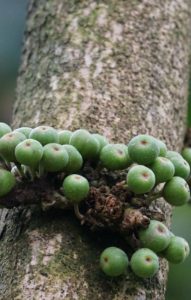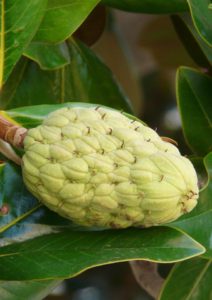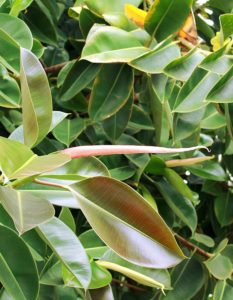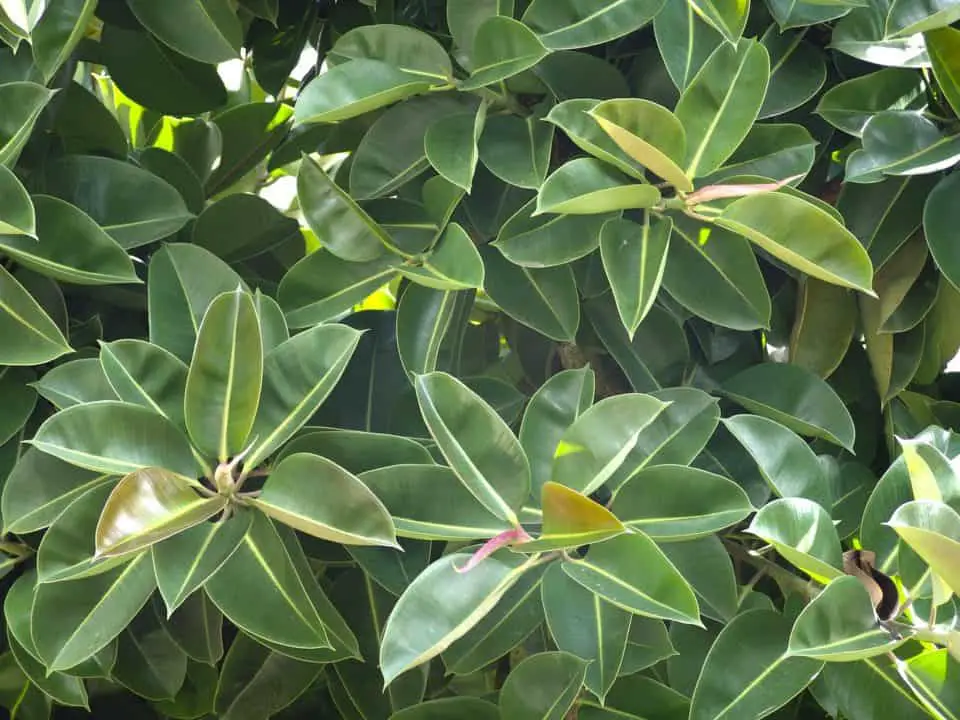Some links in the post are affiliate links and I get a commission from purchases made through some links found in the post.
Rubber plants are low-maintenance, attractive plants that make for unique indoor plants. Their leathery and vibrant leaves add allure to any space.
Plus, if you want to make a bold statement by growing a large tree, this is also possible as the plant can grow tall and wide.
Today, we will look at the most common varieties of rubber plants and what you can do to make sure the plant is healthy:
What is the Rubber Plant?
This plant goes by other names such as rubber fig, rubber tree plant, Indian rubber tree and rubber bush.
You may have noticed that the word rubber is common in all these names and may wonder why this is the case. Well, the plant produces latex which people once used to make rubber.
The rubber plant is native to south Asia and southeast Asia but has since become common in other regions such as the United States.
As long as you can provide it with ideal growing conditions, there’s no reason why this plant would not flourish in your home.
The varieties of rubber plants are:
 The Ficus elastica ‘Robusta.’
The Ficus elastica ‘Robusta.’- Ficus elastica ‘Decora.’
- Ficus elastica ‘Burgundy.’
- The Ficus elastica ‘Melany.’
- Ficus elastica ‘Doescheri.’
- Ficus elastica ‘Tricolor.’
- The Ficus elastica ‘Abidjan’
- Ficus elastica ‘Tineke.’
- Dwarf Ficus elastica
Of these, the following are the most popular varieties of rubber plants:
- The Ficus elastica ‘Robusta.’
- Ficus elastica ‘Decora.’
- Ficus elastica ‘Burgundy.’
How to Use the Rubber Plant
In the past, the sap of the plant came in handy in making rubber. Times have since changed, and now the Pará rubber tree serves this role.
If you would like to or are into DIY, you can still source rubber from the plant.
Alternatively, you can embrace its current ornamental role in sprucing up spaces.
Moreover, having an indoor plant helps purify the air in your home by eliminating toxins in the environment.
That is not to say that the plant cannot serve other roles. In India, for example, it is useful in the making of living bridges.
You can look up different ways to make use of this fascinating species.
You may also like: Why does your fiddle leaf fig have multiple stems.
Common Varieties of Rubber Plants
Ficus Elastica Robusta
This species, native to India and Indonesia, is quite similar to the original.
However, it has much glossier and broader leaves, making it ideal for anyone looking to make a statement.
It grows to heights of about 30 cm to 2 meters, depending on the care conditions. If you want it to be shorter, you can trim the plant to the desired height.
This low-maintenance plant requires the following growing conditions:
Lighting
The plant does well in bright but indirect light. When put in low light conditions, it can survive but will not thrive as much.
Watering
The plant needs water only when the soil dries at the top. The soil should be kept slightly moist. Overwatering the soil can cause leaf drop and root rot.
Temperature
Keep the temperatures between 16-24°C and avoid placing the plant in an area with cold draughts
Humidity
The plant is not specific about humidity but does great with the occasional mist
Fertilization
For a healthy plant, incorporate inputs at least once a month but only during the growing season
More on Ficus Elastica Robusta
The plant has latex in the sap, which is considered poisonous to children, pets and anyone with latex allergies.
If you touch the plant, follow up with washing your hands as latex is a known irritant.
Ficus Elastica ‘Decora
This popular houseplant boasts dark, rubbery and glossy leaves with an inconspicuous yet aesthetically appealing effect on any space.
It’s pretty easy to care for this plant which does well even in low light conditions. Even plant killers can enjoy caring for it as it can withstand some periods of neglect.
If you want some more pop, you can work with its cultivars which offer a range of variegation and colour.
For a better effect, grow this plant in a large space in your home where it can grow freely, such as a staircase void. The larger it is, the better an effect it will have on your space.
It thrives under the following conditions:
Lighting
This plant will do well in bright and indirect light. If you cannot provide this, it will adapt to low light conditions.
Watering
The soil should be kept moist more so during the warmer months. However, the soil should not be wet.
When the rainy season or cold weather starts, you should reduce the watering frequency and only water when the top soil inches are dry.
Fertilization
The plant will do well if you give it slow-release fertilizer every six months. During the growing season, give the plant a liquid fertilizer once every month.
Temperature
The plant should be in cool to warm temperatures that do not fall into the extremes.
Pruning
If you do not want the plant to grow large and wide, you can control its size by occasionally pruning it. Ideally, this should take place in the spring or summer.
Ficus Elastica ‘Burgundy.’
As the name suggests, this plant has rich burgundy red leaves that almost seem black, giving it a spectacular glossy appearance.
With adequate care, this plant can easily be a centrepiece in any room, filling a corner of your liking.
Its best care practices are:
Lighting
 It does best when it has consistent, bright and filtered light. It is under these conditions that the burgundy pops.
It does best when it has consistent, bright and filtered light. It is under these conditions that the burgundy pops.
You can achieve this by placing it near a window and filtering the sunlight using sheer curtains.
The plant will still grow in low light, only that its leaves will lose the burgundy hue and adopt a light green colour. Here is the interesting thing, though. In low light, the leaves become bigger.
Watering
Once the top inch of soil is dry, you can water the soil until the excess comes out of the drainage holes.
Ensure that the plant does not sit in water as this can drown the roots and cause root rot. Also, be careful when watering and avoid splashing water on the leaves as these can cause stains.
Humidity
The plant is native to the tropics and will do well with added humidity, more so in the summer months. Plus, misting keeps mites at bay.
Temperature
The plant will do well in temperatures ranging between 15 – 24°C. Avoid lower temperatures or cold draughts
Fertilization
During the spring and summer months, fertilize the soil every month. When winter begins, stop the fertilization.
General Rubber Plant Care Tips
We have covered care practices relating to the most common varieties rubber plants, and you may have noticed some similarities.
Instead of going through each plant, let’s now have a look at the typical requirements for these plants:
Temperature
The temperatures should range between 15 – 24°C at all times.
Anything lower than 12°C can be problematic and can induce stunted growth in the plant.
Also, avoid placing the plant in a location with sudden temperature drops or cold draughts.
Lighting
The plant should be in a location with bright but indirect light. Make sure the plant is not directly exposed to sunlight.
Where adequate light is not available, the plant will adapt to the low light conditions.
Watering
You should only water the plant if the top inch of the soil feels dry.
Make sure that the pot has enough drainage holes to allow excess water to seep.
Moreover, you should only dampen and not wet the soil; else, the plant can suffer root rot and die.
Soil
The potting mix should be well-draining too and should ideally comprise one part of coarse sand, another of pine bark and another of peat.
Aeration is also important. It would not serve you to practise good watering techniques if the soil was working against you.
Re-potting
You need to move the plant to a bigger container if the roots become rootbound. When doing so, always choose a pot that is one size bigger than the original one.
You can also re-pot the plants when they are young when moving them to another location while accounting for transplant shock.
Once the plants are settled in their new home, you can re-pot them every three years.
Soil renewal should take place each year to provide the plant with adequate nutrients.
Fertilization
Feeding should occur in the spring and summer at least once a month with some liquid fertilizer. If you want a boost in growth, you can feed the plant twice a month.
Humidity
The plant does not need added humidity and will do well with normal humidity. In the summer, you may want to mist the leaves to account for the lost moisture.
Pruning
Once the plant has reached the desired height, you can trim its top and cut back unwanted branches to achieve a full shape. Ideally, you should do this in the spring and summer months.
If you enjoyed this you may enjoy, how to take care of your coffee plant with brown leaves.
Final Thoughts: What are the Varieties of Rubber Plants?
 Caring for a rubber plant is relatively easy, and by following requirements suited to your choice, you can avoid problems such as yellowing leaves and leaf loss.
Caring for a rubber plant is relatively easy, and by following requirements suited to your choice, you can avoid problems such as yellowing leaves and leaf loss.
Also, be sure to watch out for pests such as mealybugs and mites.
Happy Gardening!
Written by: Daisy Njeri


